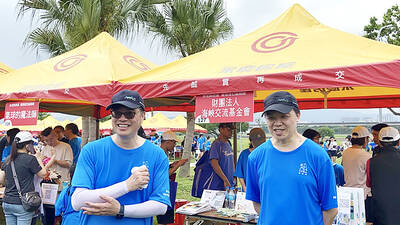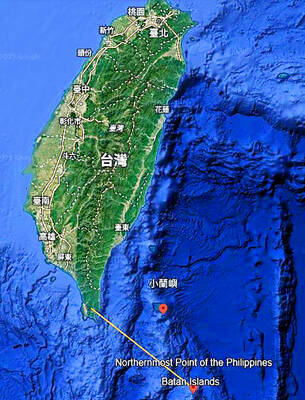The National Science Council yesterday held a ceremony with representatives of US corporations, scientific agencies and the military to publicize details of a US$5 million technology transfer program in connection with the ROCSAT-3 (
Science council officials said that ROCSAT-3 would be used to provide real-time weather monitoring data, which is essential for accurate weather forecasts.
Taiwan's National Space Program Office under the council, and the US' University Corporation for Atmospheric Research (UCAR) signed a science support contract on the ROCSAT-3 program in January, and a spacecraft contract in March.
Yesterday, the science council's chairman, Wei Che-ho (
Other US representatives at the ceremony included members of the National Science Foundation, the National Oceanic and Atmospheric Administration, the US Air Force, US Navy and officials of the American Institute in Taiwan.
The ROCSAT-3 program is a collaborative project between Taiwan and the US to develop a constellation of six low-earth orbiting satellites for weather forecasts, space weather monitoring and climate-related scientific research.
Science council officials stressed yesterday that the program was for weather-related research only and was irrelevant to national defense.
The six "constellation satel-lites," according to the program, will receive signals from the Global Positioning System (GPS). The data will be transferred to 2,500 observatories around the world. It is believed that the data will improve the precision of weather forecasting.
"ROCSAT-3 has the potential to make revolutionary improvements to weather forecasting," said David Thompson, the Orbital Science Corporation's chairman and CEO.
Scientists from both sides will work together on building a system, called the Constellation Observing System for Meteorology, Ionosphere and Climate (COS-MIC), which will have three primary components, including an advanced GPS receiver, tiny ionospheric photometer and tri-band beacon transmitter. The data collected by Taiwan's constellation satellites will be received by the US COSMIC Data Analysis & Archive Center (CDAAC) and be applied to weather forecast systems.
Five Taiwanese companies are expected to benefit from the program. Technologies will be transferred to these companies for the production of 14 spacecraft components.
National Space Program Office director Lee Lou-chuang (
Lee said that the space program office was planning to build as many as 50 constellation satellites to carry out weather-related scientific research.
Dr Richard Anthes, president of UCAR, said that he was very pleased to learn about Lee's idea.
"It's the kind of forward, leadership thinking that is important ... Other countries will quickly see the value," Anthes said. He once predicted that there would be 200 constellation satellites in orbit by 2025 to improve the precision of regional weather forecasts.

SECURITY: As China is ‘reshaping’ Hong Kong’s population, Taiwan must raise the eligibility threshold for applications from Hong Kongers, Chiu Chui-cheng said When Hong Kong and Macau citizens apply for residency in Taiwan, it would be under a new category that includes a “national security observation period,” Mainland Affairs Council (MAC) Minister Chiu Chui-cheng (邱垂正) said yesterday. President William Lai (賴清德) on March 13 announced 17 strategies to counter China’s aggression toward Taiwan, including incorporating national security considerations into the review process for residency applications from Hong Kong and Macau citizens. The situation in Hong Kong is constantly changing, Chiu said to media yesterday on the sidelines of the Taipei Technology Run hosted by the Taipei Neihu Technology Park Development Association. With

CARROT AND STICK: While unrelenting in its military threats, China attracted nearly 40,000 Taiwanese to over 400 business events last year Nearly 40,000 Taiwanese last year joined industry events in China, such as conferences and trade fairs, supported by the Chinese government, a study showed yesterday, as Beijing ramps up a charm offensive toward Taipei alongside military pressure. China has long taken a carrot-and-stick approach to Taiwan, threatening it with the prospect of military action while reaching out to those it believes are amenable to Beijing’s point of view. Taiwanese security officials are wary of what they see as Beijing’s influence campaigns to sway public opinion after Taipei and Beijing gradually resumed travel links halted by the COVID-19 pandemic, but the scale of

A US Marine Corps regiment equipped with Naval Strike Missiles (NSM) is set to participate in the upcoming Balikatan 25 exercise in the Luzon Strait, marking the system’s first-ever deployment in the Philippines. US and Philippine officials have separately confirmed that the Navy Marine Expeditionary Ship Interdiction System (NMESIS) — the mobile launch platform for the Naval Strike Missile — would take part in the joint exercise. The missiles are being deployed to “a strategic first island chain chokepoint” in the waters between Taiwan proper and the Philippines, US-based Naval News reported. “The Luzon Strait and Bashi Channel represent a critical access

Pope Francis is be laid to rest on Saturday after lying in state for three days in St Peter’s Basilica, where the faithful are expected to flock to pay their respects to history’s first Latin American pontiff. The cardinals met yesterday in the Vatican’s synod hall to chart the next steps before a conclave begins to choose Francis’ successor, as condolences poured in from around the world. According to current norms, the conclave must begin between May 5 and 10. The cardinals set the funeral for Saturday at 10am in St Peter’s Square, to be celebrated by the dean of the College